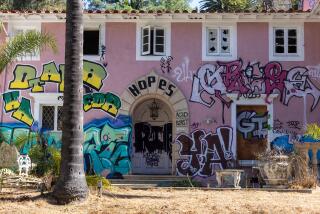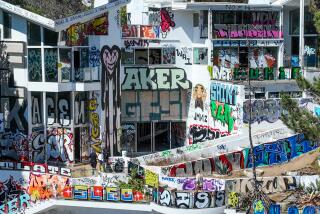Tender Mercies: How a Mansion Was Saved
- Share via
In 1910, when Beverly Boulevard at Robertson was the intersection of two tracks on an arid coastal plain, populated by a few lonely palm trees and homesteads, the owner of Rancho Cucamonga Winery commissioned a mansion for himself and his wife at 3500 W. Adams Blvd. Midtown was fashionable then, but today you might think you’re hallucinating when you see, in the middle of yet another faceless suburban area, Secundo Guasti’s palatial Beaux-Arts residence with its gated driveway, balustraded roof and sculpted lions guarding the front entrance.
The interior is no less dramatic: huge entrance hall with marble pillars and flooring, chandelier suspended from a paneled ceiling, grand semicircular staircase with a more elaborate wooden balustrade, imitation Italian Renaissance frieze of cherubs holding bunches of grapes and, in the dining room, a similar frieze of cherubs again celebrating the Wine King, this time with glasses of red wine.
After Guasti died in 1937, the mansion was bought by Busby Berkeley, creator of uniquely fantastic-erotic numbers in 1930s movie musicals. His mother moved in with him and furnished it with her collection of antiques, an extraordinary jumble that included an Early American four-poster, rococo chairs and mirrors, an intricately carved neo-Gothic table, a white-and-gold Italian chest. Berkeley converted Guasti’s wine cellar to a screening room
In 1946, when his mother died, Berkeley owed the IRS $200,000 in back taxes. He sold the mansion with all its furnishings and, like him, it fell on hard times. For almost 30 years, indifferent owners ignored the decay and rot in the gold leaf surrounding the friezes, the woodwork moldings and wall candelabra. And then the Guasti mansion found the most unexpected of rescuers when it became the headquarters of the Church of the Movement for Spiritual Awareness.
Today, with all its original architectural details seamlessly restored, including the marble reliefs above the front entrance that were damaged in the 1994 earthquake, the Guasti mansion survives as a splendid monument to the unexpectedness of Los Angeles history. The place owed its existence to the rise of a pioneer immigrant winemaker who entertained Mussolini in its marble-and-mahogany salon.
Later it became the setting for the rise and fall of a famous Hollywood figure who entertained his chorus girls in the same salon. And today it’s a center for holistic spiritual therapy, something already in the Los Angeles air, and proliferating in various forms, when Guasti built his mansion.
More to Read
Sign up for Essential California
The most important California stories and recommendations in your inbox every morning.
You may occasionally receive promotional content from the Los Angeles Times.






